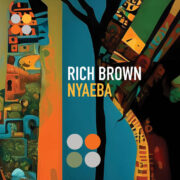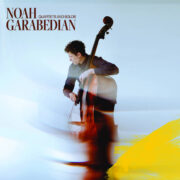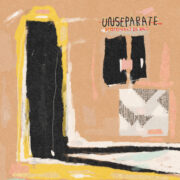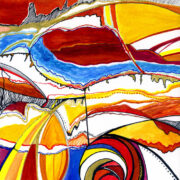We wrap September with Sweeps Week, featuring top editorial picks of the month.
 Rich Brown, Nyaeba (Whirlwind Recordings)
Rich Brown, Nyaeba (Whirlwind Recordings)
Toronto electric bassist Rich Brown succeeded Anthony Tidd in Steve Coleman’s Five Elements and appears on the band’s latest live album, PolyTropos/Of Many Turns (Pi Recordings). Nyaeba is the third outing under Brown’s name — or fourth if we’re counting Locutions, the 2008 release by his project rinsethealgorithm (featuring David Virelles and Larnell Lewis).
Stylistically Nyaeba is closer to Brown’s 2014 solo bass album Between Heaviness & Here than the 2016 full-band follow-up Abeng. There are differences, though: Brown stretches further sonically here, using only the electric bass to generate the full panoply of sounds, including rhythm tracks and percussive effects, swelling harmonies and backgrounds, elements that evoke kalimba, wood flute or synth solo patches that recall Joe Zawinul or Jan Hammer. “Kalagala Ebwembe” sounds almost like electronic dance music. The richly lyrical line playing on “The Sum of Our Tears” recalls Eberhard Weber; the percussive muting of “Ukudlala” brings to mind Lionel Loueke.
It’s worth noting that even on this solo album, others are spiritually present. “Heart of a Lonely Woman” applies the famous Ornette Coleman theme over a drone and syncopated groove. Alice Coltrane’s voice is heard during “Turiyasangitananda – The Transcendental Lord’s Highest Song of Bliss,” which leads into the infectious chord cycle and virtuosic solo flight of “The Kingdom of Heaven Is Within.”
 Noah Garabedian, Quartets and Solos (Contagious Music)
Noah Garabedian, Quartets and Solos (Contagious Music)
The follow-up to bassist Noah Garabedian’s 2022 release Consider the Stars Beneath Us is a welcome encounter with the same group: Carmen Staaf on piano, Dayna Stephens on tenor sax and EWI, Samuel Adams (son of composer John Adams) on synths, effects and programming, Jimmy Macbride on drums. Leading from the bass with Adams as producer, Garabedian sets up a sequence where compositions for quartet alternate with shorter solo episodes from each member.
The sonic treatments and post-production of Adams make the music resonate, perhaps literally, in a way that a standard jazz quartet does not. Stephens’s EWI also plays a pronounced role in that regard. Yet there’s a sense of Adams as a band member, shaping the music from the ground up, not after it’s played. Still, the improvisational and rhythmic elements are strong, not least from the leader who solos with tremendous grace and authority on “Late Stage Epiphany” and “Casual Friday.”
Adams contributes “To Speak or Sing Softly” (one of Stephens’s EWI tracks), the poignant piano melody giving a bit of a Mehldau-esque feeling. “The Mayor of Malibu” is especially well-conceived in terms of orchestration and blending acoustic and electronic sounds.
 Webber/Morris Big Band, Unseparate (Out Of Your Head Records)
Webber/Morris Big Band, Unseparate (Out Of Your Head Records)
If maintaining a big band is almost impossible, having a co-leader might make it less so. But the Webber/Morris Big Band is fueled more by the compatible visions of its principal writers and co-conductors, Anna Webber and Angela Morris, both credited on tenor sax and flute on this, the band’s sophomore outing (after Both Are True, 2020).
Those familiar with Webber’s 2023 quintet release Shimmer/Wince (Intakt) know something of her interest in just intonation, in particular her study of “the relationship between pitch and rhythm,” as she has put it. This involves intervallic ratios in the overtone series — matters too complex to detail here, except to say that breaking out of the box of Western equal temperament can yield fascinating results, which Webber’s four-movement “Just Intonation Etudes for Big Band” makes vividly clear.
Given the deviation from “normal” interval and pitch organization in this music, one might assume it will sound “out of tune” (i.e., desafinado), or harshly dissonant, and at a given moment it might be. But it seems the composer has as many choices here as in any system, if not more.
There are consonant and melodious passages on Unseparate, and inspired improvisation over ragged rhythm and harmony and form, from both principals as well as the brilliant trumpeters Jake Henry and Kenny Warren, baritone saxophonist Lisa Parrott, multireedists Jay Rattman and Charlotte Greve, trombonist Zekkereya El-magharbel, pianist Marta Sánchez and vibraphonist Yuhan Su.
Morris’s main contributions are “Mist/Missed,” “Microchimera” and “Habitual.” Webber’s “Spur 7: Metamorphosis” closes with broken-up beats, big bass trombone and a fine arco bass solo from Out Of Your Head label founder Adam Hopkins.
 Simón Willson, Feel Love (Endectomorph/La Reserve)
Simón Willson, Feel Love (Endectomorph/La Reserve)
Chilean-born bassist Simón Willson has gained a higher profile through recent sideman work with Dave Douglas and Ethan Iverson, though he built his reputation on the New York scene in groups with tenor saxophonist Kevin Sun and other peers. Interestingly, Sun produced Feel Love, Willson’s third album as a leader, after Good Company (Fresh Sound New Talent, 2023) and Bet: Live at Ornithology (Giant Step Arts), from February of this year. That makes Feel Love Willson’s second album of 2025, featuring the same seasoned band with tenor saxophonist Neta Raanan, pianist Evan Main and drummer Kayvon Gordon.
Willson and Gordon appeared alongside vibraphonist Joel Ross on Raanan’s 2024 Giant Step Arts live recording Unforeseen Blossom. The shared experience is abundant and the chemistry just as fresh on Feel Love, which includes all Willson originals — detailed, melodic, rhythmically challenging, roomy enough for the soloists to stretch and create. Catch how the time pulls apart and coalesces again during Raanan’s tenor solo on “Shades,” or how Main is suddenly all alone after the head on the closing “Show You Out,” deftly soloing in isolation for about 30 seconds before the rhythm section rejoins and starts to burn.
Hearing the quartet documented live and in the studio in the same year makes for an absorbing listen. Only two tunes appear on both albums, “Feel Love” and “Jog.” The live version of the former has no tenor, but Raanan plays on the studio version, bringing more clarity to the counterpoint. Willson’s introspective solo bass intro is another stark contrast. “Jog” on the bandstand had an elastic feel in the drums, not what Gordon went for in the studio — perhaps at Sun’s suggestion or Willson’s, the drum part is more precise, centered around the snare, allowing the momentum to gather more gradually. JT
